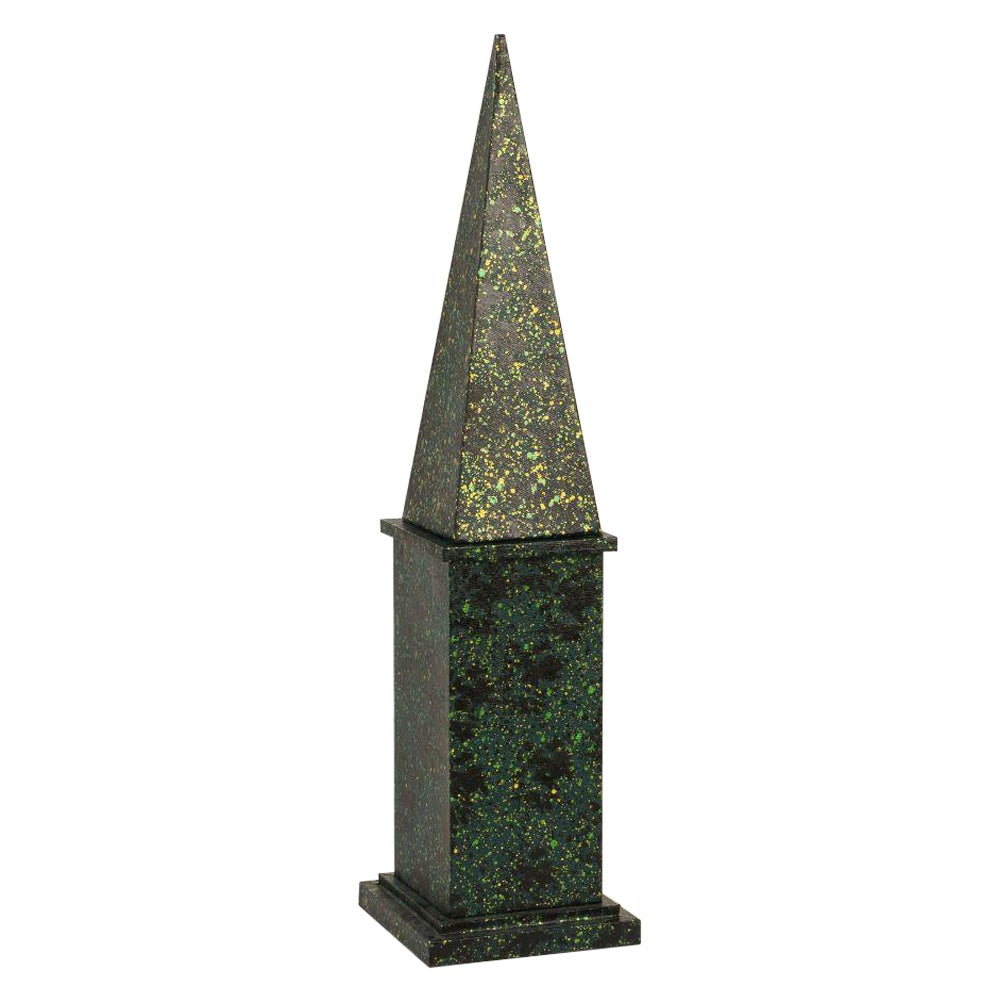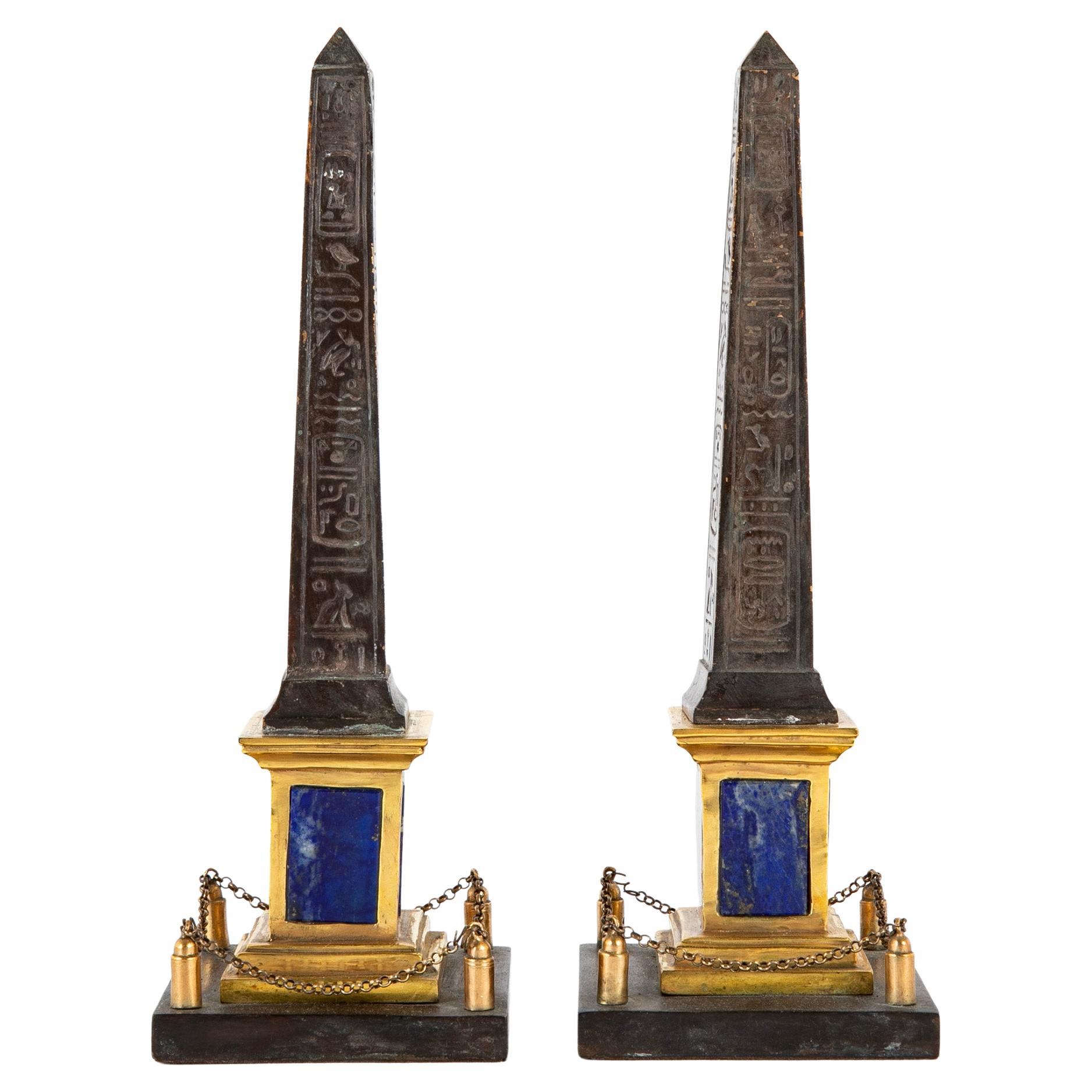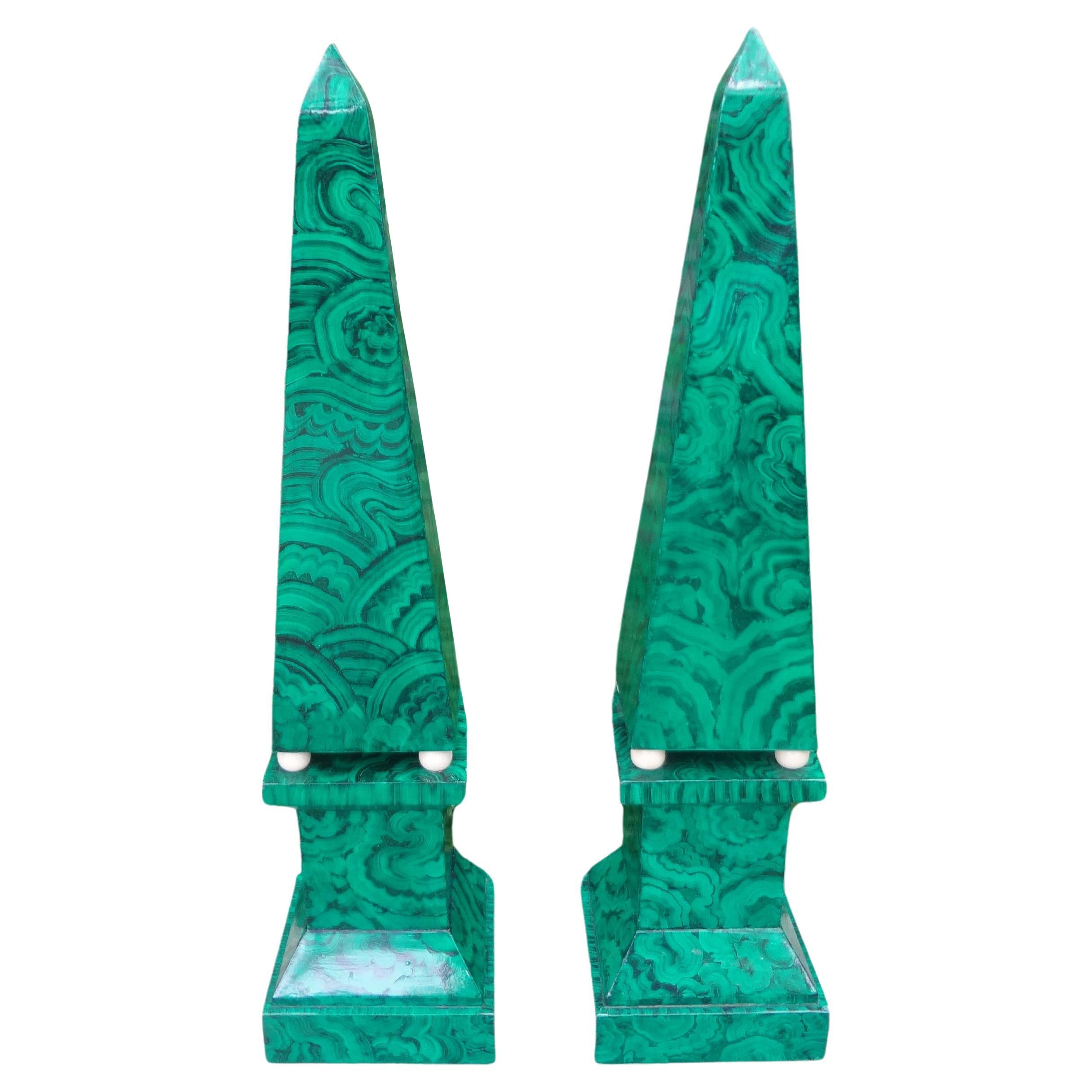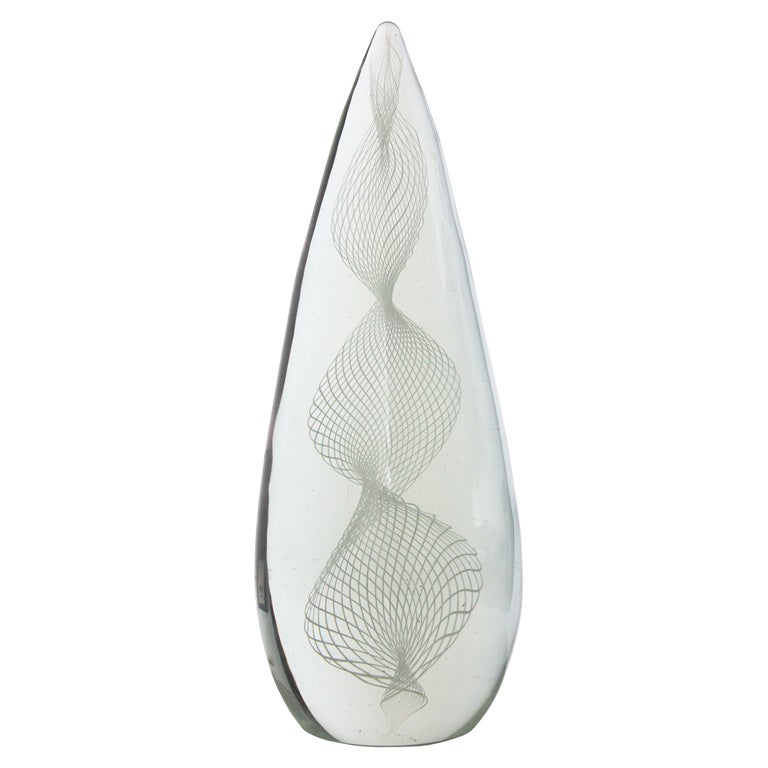Items Similar to A Set of Four Large Porphyry Obelisks With Roundels of the Roman Emperors
Want more images or videos?
Request additional images or videos from the seller
1 of 12
A Set of Four Large Porphyry Obelisks With Roundels of the Roman Emperors
About the Item
An Important Set of Four Large Porphyry Obelisks.
Each obelisk is of square section tapering form with a spiked orb finial and embellished with carved roundels of the twelve Roman Emperors in profile. The main body is raised on ball supports putdown on square sectioned plinth bases.
Each obelisk is carved with three Emperors profile medallions on a alabaster ground and the fourth medallion inscribed with the names and dates of the Emperors:
GALBA 68.69 OTHO 68.69 VITALLIUS G8.68,
VESPANISIANUS 69.79. TITUS 69.81. DOMITIANUS 81.96
IVULI 48.44 AVGVST 27.14 TIBERIVS 14.37.
CALIVULA 37.41. CLAUDIVS 41.54. NERO 54.68.
Italian, 20th Century.
Porphyry is a remarkably hard, durable rock, which in antiquity derived its name from the fact that its intense, dark red colour, speckled with white inclusions, is similar to the purple colour called purpura by the Romans. The name was extended by association to the massif where porphyry was quarried in Egypt, which the Romans called Mons Porphyrites.
The Romans began to quarry porphyry in the First Century BC, employing it in such large quantities that by the Fifth Century AD the quarries were nearly exhausted. It was used extensively for monumental elements, and it became invested with an Imperial symbolism, perhaps on account of its analogy with the purpura, which from ancient times had been seen as the perogative of regal dignity. The use of Porphyry was in fact limited by Diocletian to the Imperial family.
The Romans used this porphyry for the Pantheon's inlaid panels, for the togas in the sculpted portraiture of their emperors, and for the monolithic pillars of Baalbek's Temple of Heliopolis in Lebanon. Today there remain at least 134 porphyry columns in buildings around Rome, all reused from imperial times, and countless altars, basins and other objects.
Byzantium, too, was enamoured of porphyry. Constantine the Great celebrated the founding of his new capital, Constantinople (later Istanbul), in the year 330 by erecting there a 30-meter (100') pillar, built of seven porphyry drums, or cylinders, that still stands. Eight monolithic columns of porphyry support Hagia Sophia's exedrae, or semicircular niches. Justinian's chronicler, Procopius, called the columns "a meadow with its flowers in full bloom, surely to make a man marvel at the purple of some and at those on which the crimson glows."
Porphyry served the imperium in death as well as birth. Nero was the first emperor to be entombed in a porphyry sarcophagus, according to Suetonius. Constantine's porphyry sarcophagus has been lost, but that of his wife Constantia, decorated with peacocks, lambs, and grapes and thought to be a copy of his, is now in the collection of the Vatican Library. Those of the Holy Roman Emperors Frederick II, Henry IV and William I, and that of the Empress Constance, all porphyry, are in Sicily's Palermo and Monreale cathedrals.
In later centuries, porphyry columns and other pieces were widely reused in new constructions, often reappearing far from their original Roman context. In 786, Charlemagne received permission from Pope Hadrian to remove classical columns of porphyry from Rome to build his cathedral at Aachen.
This sacred and celebrative significance of Porphyry continued to be greatly appreciated in the Renaissance courts and it was to become a much sought after material by Sixteenth Century collectors. In Florence, Grand Duke Cosimo I, had a particular liking for this stone and sponsored its use in large-scale sculptural works. Given that the ability to execute large sculptural works in this arduous material had long since been lost, such works represented a remarkable technical accomplishment.
- Dimensions:Height: 76.78 in (195 cm)Width: 15.75 in (40 cm)Depth: 15.75 in (40 cm)
- Style:Neoclassical (In the Style Of)
- Materials and Techniques:
- Place of Origin:
- Period:
- Date of Manufacture:20th Century
- Condition:Wear consistent with age and use.
- Seller Location:Brighton, GB
- Reference Number:
About the Seller
5.0
Recognized Seller
These prestigious sellers are industry leaders and represent the highest echelon for item quality and design.
Platinum Seller
These expertly vetted sellers are 1stDibs' most experienced sellers and are rated highest by our customers.
Established in 1964
1stDibs seller since 2014
48 sales on 1stDibs
Typical response time: 1 hour
Associations
The British Antique Dealers' AssociationLAPADA - The Association of Arts & Antiques Dealers
- ShippingRetrieving quote...Ships From: Brighton, United Kingdom
- Return PolicyA return for this item may be initiated within 7 days of delivery.
More From This SellerView All
- Important Set of Four Large Porphyry ObelisksLocated in Brighton, West SussexAn important set of four large Porphyry Obelisks. Each obelisk is of square section tapering form with a spiked orb finial and embellished with carved roundels of the twelve Roman Emperors in profile. The main body is raised on ball supports putdown on square sectioned plinth bases. Each obelisk is carved with three Emperors profile...Category
Antique 19th Century Italian Neoclassical Pedestals and Columns
MaterialsPorphyry
- A Pair Of White Marble Portrait Roundels of 'Morning' and 'Evening'Located in Brighton, West SussexA Pair Of White Marble Portrait Roundels Of Female Portraits Representing 'Morning' and 'Evening', By Madison Colby (American, 1842-1871). White statuary marble. 'Morning' signed ’...Category
Antique 19th Century Italian Wall-mounted Sculptures
MaterialsCarrara Marble
- Louis XVI Style Cut-Glass Travel Nécessaire by Boin Taburet, circa 1880By Boin-TaburetLocated in Brighton, West SussexAn exceptional Louis XVI style silver-gilt and cut-glass travel nécessaire by Boin Taburet. French, circa 1880. The lock engraved ‘BOIN TABURET 3, rue Pasquier, Paris’. Thi...Category
Antique Late 19th Century French Louis XVI Trunks and Luggage
MaterialsSilver
- A Fine Louis XV Style Giltwood and Oil on Panel Three-Panelled ScreenLocated in Brighton, West SussexA Fine Louis XV Style Giltwood and Oil on Panel Three-Panelled Screen, Painted By Juderías Caballero (Spanish, 1867-1951). Signed 'J. Caballero. Paris'. The giltwood frame enclosi...Category
Antique 19th Century French Screens and Room Dividers
MaterialsGlass, Giltwood
- Set of Four Gilt-Bronze Wall AppliquesLocated in Brighton, West SussexA fine set of four Louis XIV style gilt-bronze wall appliques. Each applique having a backplate cast with palmettes and fronded acanthus and i...Category
Antique 19th Century French Louis XIV Wall Lights and Sconces
MaterialsBronze, Ormolu
- A Set of Four Mahogany And Gilt-Bronze Second Empire Style Salon Chairs in the MLocated in Brighton, West SussexA Set of Four Mahogany And Gilt-Bronze Second Empire Salon Chairs in the Manner of Jacob-Desmalter. French, Circa 1880.Category
Antique 19th Century French Empire Revival Side Chairs
MaterialsOrmolu
You May Also Like
- Green Porphyry ObeliskBy Thomas EngelhartLocated in New York, NYSigned and dated by artist on underside; Acrylic and shellac based inks on Ingres paper. From architectural follies of the eighteenth-century to crystalline rock formations, Thomas Engelhart translates the angles and polished surfaces of ancient artifacts into hand-painted paper objects. A Charleston, South Carolina native, Engelhart began his career in fashion, studying at Studio Berçot in Paris in the 1990s. His intuitive eye and meticulous attention to detail were cultivated designing for famed houses such as Thierry Mugler and Hermès. “Paris gave me elegance, rigor, and an understanding of quality,” reflects the artist. By absorbing the French approach to fait à la main, Engelhart flourished upon his return to New York in 2017. Engelhart’s papered obelisks and pyramid boxes are the result of a passion for antique curiosities...Category
2010s American Post-Modern Obelisks
MaterialsPaint, Paper
- Pair of Patinated and Gilt Hieroglyphed Roman ObelisksLocated in Stamford, CTPair of 19th century patinated and gilt hieroglyphed Roman obelisks having lapis lazuli panel inserts in base.Category
Antique Mid-19th Century Obelisks
MaterialsBronze
- Set of four Red Marble Obelisks and Ornaments, 19th centuryLocated in Greding, DEFour-piece marble set with obelisks made of different types of marble.Category
Antique 19th Century Unknown Obelisks
MaterialsMarble
- Pair of Large Carved Wood Faux Malachite ObelisksBy Paul HansenLocated in Houston, TXPair of large carved wood faux Malachite Obelisks. Offered is a stunning pair of Hollywood Regency style carved wood obelisks. This pair of large scale hand decorated neoclassical f...Category
Vintage 1970s Unknown Neoclassical Obelisks
MaterialsWood
- Pair of Grand Tour Porphyry and Sienna Marble Obelisks, Italian, 19th CenturyLocated in Spencertown, NYThe porphyry obelisks on sienna 'marmo giallo' and porphyry base, condition: 2 small cracks on 1 base and a repair to the other on top of base. Condition commensurate with age and use.Category
Antique Late 19th Century Italian Grand Tour Obelisks
MaterialsMarble, Porphyry
- large glass obeliskBy VeniniLocated in Toronto, OntarioA large hand blown glass obelisk with internal canes or filigranaCategory
Vintage 1950s Italian Obelisks
MaterialsGlass
Recently Viewed
View AllMore Ways To Browse
Niche Altar
Used Home Accents
Emperor Hadrian
Russian Malachite Obelisks
Pair Of Crystal Grand Tour Obelisks
Obelisk Pair Red Marble
6 X 8
Ceramic Servingware
Mid Back Chairs
New Ceramics
Wrought Iron Furniture
Mid Century Modern Cocktail Coffee Table
Vintage Pink Furniture
Vintage Modern Wall Art
Square Side
Rugs Silk
Cast Table
The Runners





